The Cryogenic Anticoincidence Detector for the NewAthena X-IFU Instrument: A Program Overview
Abstract
:1. Introduction
- How and why does ordinary matter assemble into the structures (galaxies, galaxy groups and galaxy clusters) that we see today?
- How do black holes grow and shape their environment, as well as the cosmological evolution of the galaxies hosting them?
2. Geant4 Simulations for X-IFU
3. CryoAC Design Concept: A Detector Aimed at Reducing the Particle Background
- Four bridged-suspended Si absorbers to have a well-controlled “G” thermal conductance;
- Ir/Au TESes on each absorber surface;
- Distance from TES array <1 mm;
- Pt Heaters deposited onto the absorber to increase its temperature.
- ○
- to decrease bias currents, thus limiting both power dissipation and magnetic coupling effects to the main detector TES array (to be traded-off with Rshunt bias circuit shunt resistance);
- ○
- Detector diagnostics, energy calibration.
3.1. Illumination by 6 keV Photons (55Fe)
- We stimulated the detector by 241Am (shielded source to illuminate the chip by only ~60 keV photons) and recorded both a nice energy resolution (<1 keV@60 keV) and the Compton continuum down to less than 10 keV (compliant with results from Geant4 simulation);
- We validated the detector energy calibration by an on-chip heater (0.5 keV accuracy up to 60 keV) against 6 keV photons (55Fe) and ~60 keV photons (241Am).
3.2. Phonon Physics Investigation: Simulation of Athermal Phonons
3.3. Present CryoAC Concept
- Thermal validation to verify the effect on the low energy threshold and deadtime (i.e., saturation energy) of the monolithic option not yet closed (such quantities are affected by the thermal capacity being four times of each single pixel related to the segmented layout). Given the results from DM#127 (see also [26]), starting from more than one order of magnitude, we are now at a factor of few as accuracy between data and model, but we need a new sample to confirm our model. The thermal validation model (remember that the CryoAC mainly works outside the small signal approximation) is necessary to assess
- ○
- Silicon beams aspect ratio to comply with the deadtime requirements (it affects the thermal conductance, thus the time constant);
- ○
- S/N ratio to comply with the low energy threshold, then the rejection efficiency and the NXB (the detector thermal capacity affects the energy resolution)
- ○
- Shunt resistors value and optimal bias current to comply with power dissipation requirements (the shunt resistor affects the TES voltage bias quality then the detector ElectroThermal Feedback)
- Experimental test on wide absorber area (>1 cm2) to verify effects on absorber thermal inhomogeneity:
- ○
- Absorber thermal capacity: an increase in the absorber thermal capacity can increase the thermal rise time constant and decrease its temperature variation after energy deposition. Deadtime vs. low-energy threshold needs to be investigated;
- ○
- TES aspects: it is necessary to guarantee deposition homogeneity of TES over several cm2 absorber area to avoid position dependence of the critical temperature and negligible thermal gradient over wide area. Activity not yet started.
- How many TESs are necessary to deposit per pixel? We have to produce chip to better understand the behavior, but from simulation on phonon physics we have a guide;
- Being that the CryoAC assembly is stressed by vibration during the rocket launch phase, structural models (SMs) have to be produced to assess, by experimental test, how the vibration load at assembly level affects its performance (break, etc.). This activity is divided in three phases:
- ○
- “SM0” which is only the silicon hexagonal chip, both monolithic and segmented, glued on an interface to retrieve starting information from the chip behavior under vibration (this is a “zero” level activity to understand the response of the chip alone);
- ○
- “SM1” has the same chip geometry but is glued on a hexagonal supporting structure (see Figure 13) and does not have a representative interface with the FPA (this assembly has been designed by taking into account an old allocated envelope provided by the FPA team, and it has been analyzed by FEM [30])
- ○
- “SM2” has the same chip geometry glued on a hexagonal supporting structure but has a representative mechanical, electrical and thermal interface with the FPA.
- Cold stage: Four TESes pixels with CFEE composed by four SQUID to readout each TES and a thermometer to measure the PCB temperature. This is the cryogenic assembly cooled down to 50 mK;
- WFEE (warm front-end electronics) divided in four quadrants: each one provides bias to TES and SQUID of a single pixel and produces the analog scientific signal (AC OUT) and the housekeepings. SQUID are read out in a standard FLL (flux locked loop, see [33] and Ref. therein) readout (no multiplexing technique is necessary given the very low TES number to be read out);
- WBEE in nominal and redundant boards: each one processes and digitizes the signal from the WFEE into packets of data to be sent to the instrument control unit. Veto operation will be performed on ground, given the expected modest TeleMetry rate.
4. Critical Technologies: The Steps to Enable CryoAC Detector Production
- Chip/film processes (Etching, Ir/Au TES, Nb/SiO2/Nb stripline)
- Film growth (Ir uniformity and on-site quality monitoring, Nb and Au cross interference, SiO2 isolation)
- Environmental particulate contamination (Clean Room over the film growth & test area, Connection to Lithography Clean Room)
5. Conclusions
- Single process procedure consolidation (bi-layer deposition, TES RIE, Si Deep RIE);
- Closure of the thermal and athermal validation;
- CryoAC rejection efficiency measurement at a beam test facility (tentatively BTF@Frascati);
- SM1 activity.
Author Contributions
Funding
Data Availability Statement
Acknowledgments
Conflicts of Interest
References
- Nandra, K.; Barret, D.; Barcons, X.; Fabian, A.; Herder, J.W.D.; Piro, L.; Watson, M.; Adami, C.; Aird, J.; Afonso, J.M.; et al. The Hot and Energetic Universe: A White Paper presenting the science theme motivating the Athena+ mission. arXiv 2013, arXiv:1306.2307. [Google Scholar] [CrossRef]
- Barret, D.; Albouys, V.; Herder, J.W.D.; Piro, L.; Cappi, M.; Huovelin, J.; Kelley, R.; Mas-Hesse, J.M.; Paltani, S.; Rauw, G.; et al. The Athena X-ray Integral Field Unit: A consolidated design for the system requirement review of the preliminary definition phase. ExpA 2023, 55, 373–426. [Google Scholar] [CrossRef]
- Meidinger, N.; Albrecht, S.; Beitler, C.; Bonholzer, M.; Emberger, V.; Frank, J.; Lederhuber, A.; Müller-Seidlitz, J.; Nandra, K.; Oser, J.; et al. Development status of the wide field imager instrument for Athena. Proc. SPIE 2020, 11444, 114440T. [Google Scholar] [CrossRef]
- Advanced Example Xray_TESdetector. Available online: https://geant4.web.cern.ch/docs/advanced_examples_doc/example_xray_TESdetector (accessed on 1 September 2023).
- Advanced Example Xray_SiliconPoreOptics. Available online: https://geant4.web.cern.ch/docs/advanced_examples_doc/example_xray_SiliconPoreOptics (accessed on 1 September 2023).
- AREMBES Overview. Available online: https://indico.esa.int/event/304/contributions/5116/attachments/3697/5147/arembes_overview.pptx (accessed on 1 September 2023).
- The EXACRADProject in Context. Available online: https://indico.esa.int/event/324/contributions/5100/attachments/3806/5346/molendi_TEC-EPS_ESTEC_12_19.pdf (accessed on 1 September 2023).
- AHEAD. Available online: https://ahead.iaps.inaf.it/ (accessed on 1 September 2023).
- Lotti, S.; D’Andrea, M.; Molendi, S.; Macculi, C.; Minervini, G.; Fioretti, V.; Laurenza, M.; Jacquey, C.; Piro, L. Review of the Particle Background of the Athena X-IFU Instrument. Astrophys. J. 2021, 909, 111. [Google Scholar] [CrossRef]
- Lotti, S.; D’Andrea, M.; Macculi, C.; Piro, L.; Kilbourne, C.; McCammon, D.; Kraft, R. Benefits of the use of Monte Carlo simulations in cryogenic detectors design. J. Low Temp. Phys. 2023; in preparation. [Google Scholar]
- Macculi, C.; Argan, A.; Brienza, D.; D’Andrea, M.; Lotti, S.; Minervini, G.; Piro, L.; Biasotti, M.; Barusso, L.F.; Gatti, F.; et al. The Cryogenic AntiCoincidence detector for ATHENA X-IFU: Advancement in the project. Proc SPIE 2020, 11444, 114444A. [Google Scholar] [CrossRef]
- Biasotti, M.; Boragno, C.; Ferrari Barusso, L.; Gatti, F.; Grosso, D.; Rigano, M.; Siri, B.; Macculi, C.; D’Andrea, M.; Piro, L. The Phonon-Mediated TES Cosmic Ray Detector for Focal Plane of ATHENA X-Ray Telescope. J. Low Temp. Phys. 2020, 199, 225–230. [Google Scholar] [CrossRef]
- Martinez, M.; Cardani, L.; Casali, N.; Cruciani, A.; Pettinari, G.; Vignati, M. Measurements and Simulations of Athermal Phonon Transmission from Silicon Absorbers to Aluminum Sensors. Phys. Rev. Appl. 2019, 11, 064025. [Google Scholar] [CrossRef]
- Kozorezov, A.G.; Lambert, C.J.; Bandler, S.R.; Balvin, M.A.; Busch, S.E.; Nagler, P.N.; Porst, J.P.; Smith, S.J.; Stevenson, T.R.; Sadleir, J.E. Athermal energy loss from X-rays deposited in thin superconducting films on solid substrates. Phys. Rev. B 2013, 87, 104504. [Google Scholar] [CrossRef]
- Lindeman, M. Microcalorimetry and the Transition-Edge Sensor. Ph.D. Thesis, University of California, Davis, CA, USA, 2000. Available online: https://www.osti.gov/servlets/purl/15009469 (accessed on 1 September 2023).
- Agnese, R.; Anderson, A.J.; Aralis, T.; Aramaki, T.; Arnquist, I.J.; Baker, W.; Balakishiyeva, D.; Barker, D.; Thakur, R.B.; Bauer, D.A.; et al. Low-mass dark matter search with CDMSlite. Phys. Rev. D 2018, 97, 022002. [Google Scholar] [CrossRef]
- Petricca, F.; Angloher, G.; Bauer, P.; Bento, A.; Bucci, C.; Canonica, L.; Defay, X.; Erb, A.; Feilitzsch, F.; Iachellini, N.F.; et al. First results on low-mass dark matter from the CRESST-III experiment. arXiv 2017, arXiv:1711.07692. [Google Scholar] [CrossRef]
- Adams, D.Q.; Alduino, C.; Alfonso, K.; Avignone, F.T., III; Azzolini, O.; Bari, G.; Bellini, F.; Benato, G.; Beretta, M.; Biassoni, M.; et al. Search for neutrinoless + EC Decay of 120 Te with CUORE-0. Phys. Rev. C 2018, 97, 055502. [Google Scholar] [CrossRef]
- Macculi, C.; Piro, L.; Colasanti, L.; Lotti, S.; Natalucci, L.; Bagliani, D.; Biasotti, M.; Gatti, F.; Torrioli, G.; Barbera, M.; et al. The Cryogenic AntiCoincidence Detector Project for ATHENA+: An Overview Up to the Present Status. J. Low Temp. Phys. 2014, 176, 1022–1032. [Google Scholar] [CrossRef]
- Macculi, C.; Argan, A.; D’Andrea, M.; Lotti, S.; Piro, L.; Biasotti, M.; Corsini, D.; Gatti, F.; Orlando, A.; Torrioli, G. The Cryogenic AntiCoincidence Detector for the ATHENA X-IFU: Design Aspects by Geant4 Simulation and Preliminary Characterization of the New Single Pixel. J. Low Temp. Phys. 2016, 184, 680–687. [Google Scholar] [CrossRef]
- D’Andrea, M.; Macculi, C.; Argan, A.; Lotti, S.; Minervini, G.; Piro, L.; Biasotti, M.; Corsini, D.; Gatti, F.; Torrioli, G. The Cryogenic AntiCoincidence Detector for ATHENA X-IFU: Assessing the Role of the Athermal Phonons Collectors in the AC-S8 Prototype. J. Low Temp. Phys. 2018, 193, 949–957. [Google Scholar] [CrossRef]
- D’Andrea, M.; Macculi, C.; Argan, A.; Lotti, S.; Minervini, G.; Piro, L.; Biasotti, M.; Ceriale, V.; Gallucci, G.; Gatti, F.; et al. The Cryogenic Anticoincidence Detector for ATHENA X-IFU: Preliminary test of AC-S9 towards the Demonstration Model. Proc. SPIE 2018, 10699, 106994T-1. [Google Scholar] [CrossRef]
- D’Andrea, M.; Argan, A.; Lotti, S.; Macculi, C.; Piro, L.; Biasotti, M.; Corsini, D.; Gatti, F.; Torrioli, G. The Cryogenic Anti-Coincidence detector for ATHENA X-IFU: Pulse analysis of the AC-s7 single pixel prototype. Proc. SPIE 2016, 9905, 99055X-1–99055X-11. [Google Scholar] [CrossRef]
- D’Andrea, M.; Macculi, C.; Torrioli, G.; Argan, A.; Brienza, D.; Lotti, S.; Minervini, G.; Piro, L.; Biasotti, M.; Ferrari Barusso, L.; et al. The Demonstration Model of the ATHENA X-IFU Cryogenic AntiCoincidence Detector. J. Low Temp. Phys. 2020, 199, 65–72. [Google Scholar] [CrossRef]
- D’Andrea, M.; Ravensberg, K.; Argan, A.; Brienza, D.; Lotti, S.; Macculi, C.; Minervini, G.; Piro, L.; Torrioli, G.; Chiarello, F.; et al. ATHENA X-IFU Demonstration Model: First Joint Operation of the Main TES Array and its Cryogenic AntiCoincidence Detector (CryoAC). J. Low Temp. Phys. 2022, 209, 433–440. [Google Scholar] [CrossRef]
- D’Andrea, M.; Macculi, C.; Lotti, S.; Piro, L.; Argan, A.; Minervini, G.; Torrioli, G.; Chiarello, F. The TES-based Cryogenic AntiCoincidence Detector (CryoAC) of ATHENA X-IFU: A large area silicon microcalorimeter for background particles detection. J. Low Temp. Phys. 2023; in preparation. [Google Scholar]
- Chiarello, F.; Torrioli, G.; Argan, A.; D’Andrea, M.; Macculi, C.; Piro, L. Study on the trigger logic for the X-IFU Athena anticoincidence system. Proc. SPIE 2022, 12181, 1218141-1–1218141-8. [Google Scholar] [CrossRef]
- Barusso, L.F.; Boragno, C.; Celasco, E.; Fedkevych, M.; Gallucci, G.; De Gerone, M.; Grosso, D.; Repetto, L.; Niazi, K.; Rigano, M.; et al. First Configurational Study of the CryoAC Detector Silicon Chip of the Athena X-Ray Observatory. IEEE Trans. Appl. Supercond. 2023, 33, 2100207. [Google Scholar] [CrossRef]
- Ferrari Barusso, L.; Boragno, C.; Celasco, E.; Gallucci, G.; Grosso, D.; Niazi, K.; D’Andrea, M.; Macculi, C.; Torrioli, G.; Gatti, F. The signal generation in the TES-based Cryogenic AntiCoincidence Detector (CryoAC) of ATHENA X-IFU: A-thermal and thermal signal model and detection. In Proceedings of the 36th International Symposium on Superconductivity (ISS2023), Wellington, New Zealand, 28–30 November 2023. [Google Scholar]
- OHB Italia. CryoAC SM Analysis Report. ATH-RP-CGS-002, Issue 1. 2019. Available online: http://www.ohb-italia.it (accessed on 1 September 2023).
- Barusso, L.F.; Tarassi, P.; Tugliani, S.; De Gerone, M.; Fedkevych, M.; Gallucci, G.; Rigano, M.; Argan, A.; Brienza, D.; D’Andrea, M.; et al. First structural tests of the CryoAC Detector silicon chip of the Athena X-ray observatory. Nucl. Instrum. Methods Phys. Res. Sect. A 2023, 1047, 167862. [Google Scholar] [CrossRef]
- The ESA Science Technology Development Route. Available online: https://sci.esa.int/web/sci-ft/-/50124-technology-readiness-level (accessed on 1 September 2023).
- Drung, D. High-performance DC SQUID read-out electronics. Phys. C Supercond. 2002, 368, 134–140. [Google Scholar] [CrossRef]
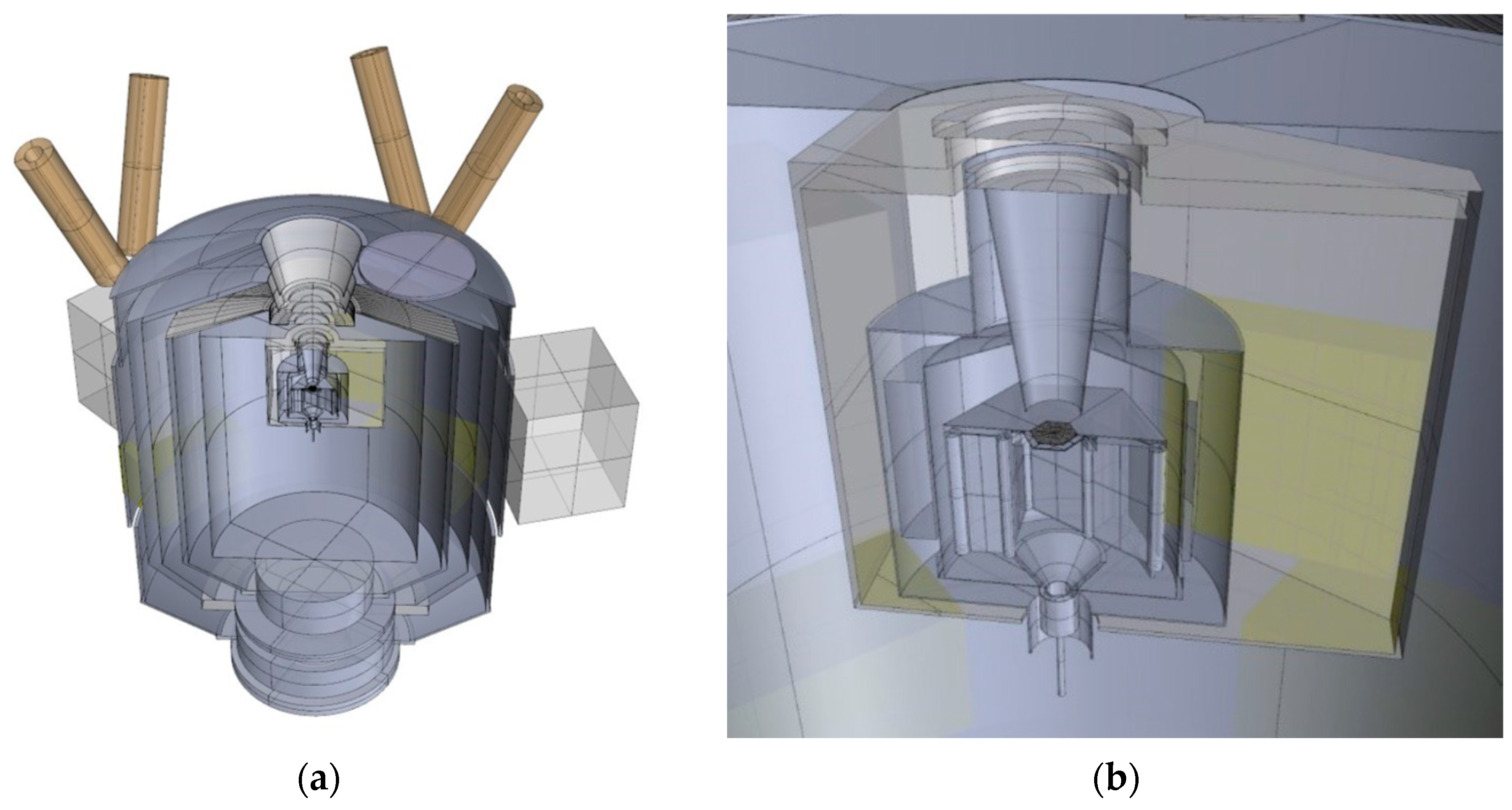
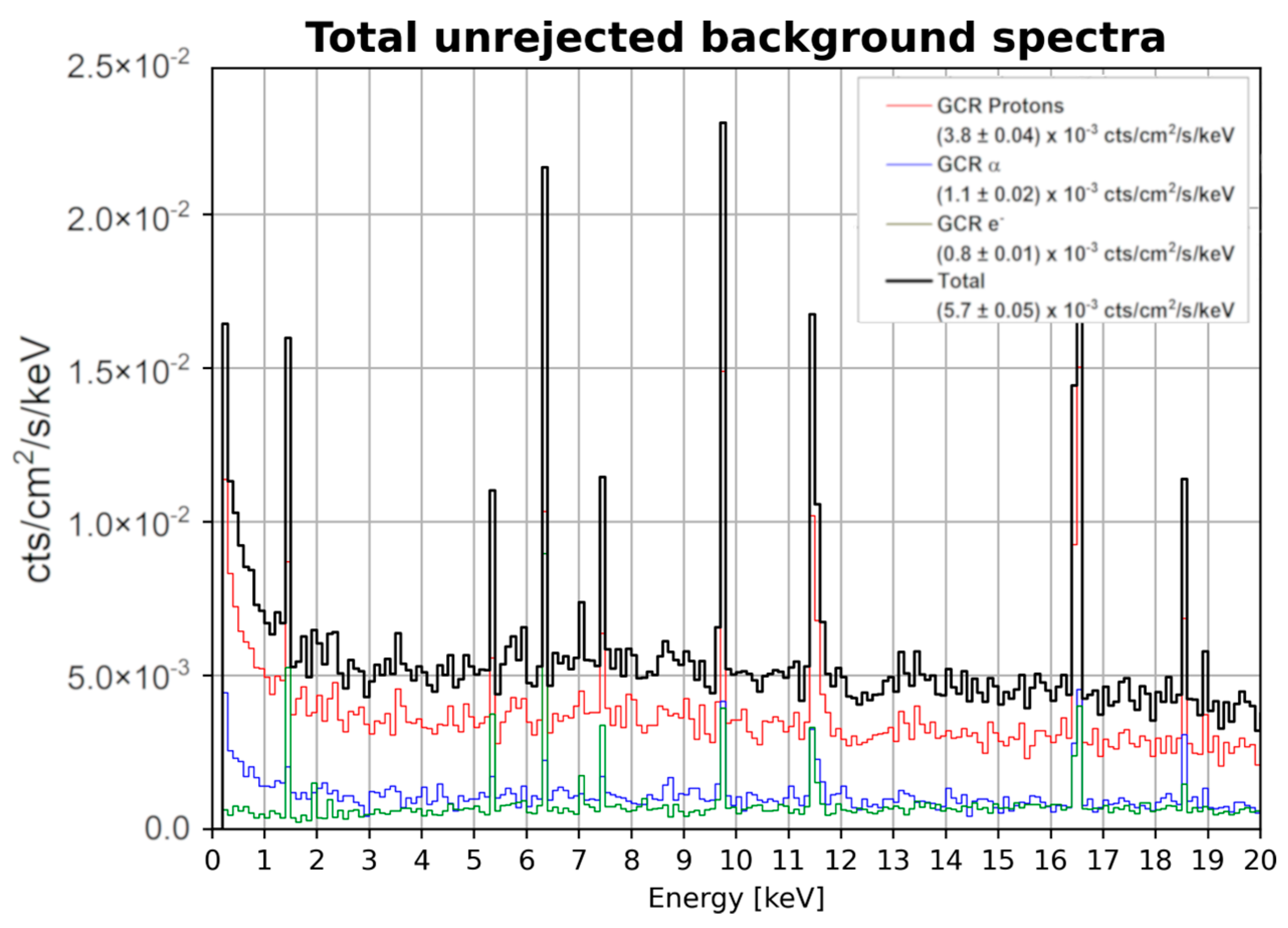



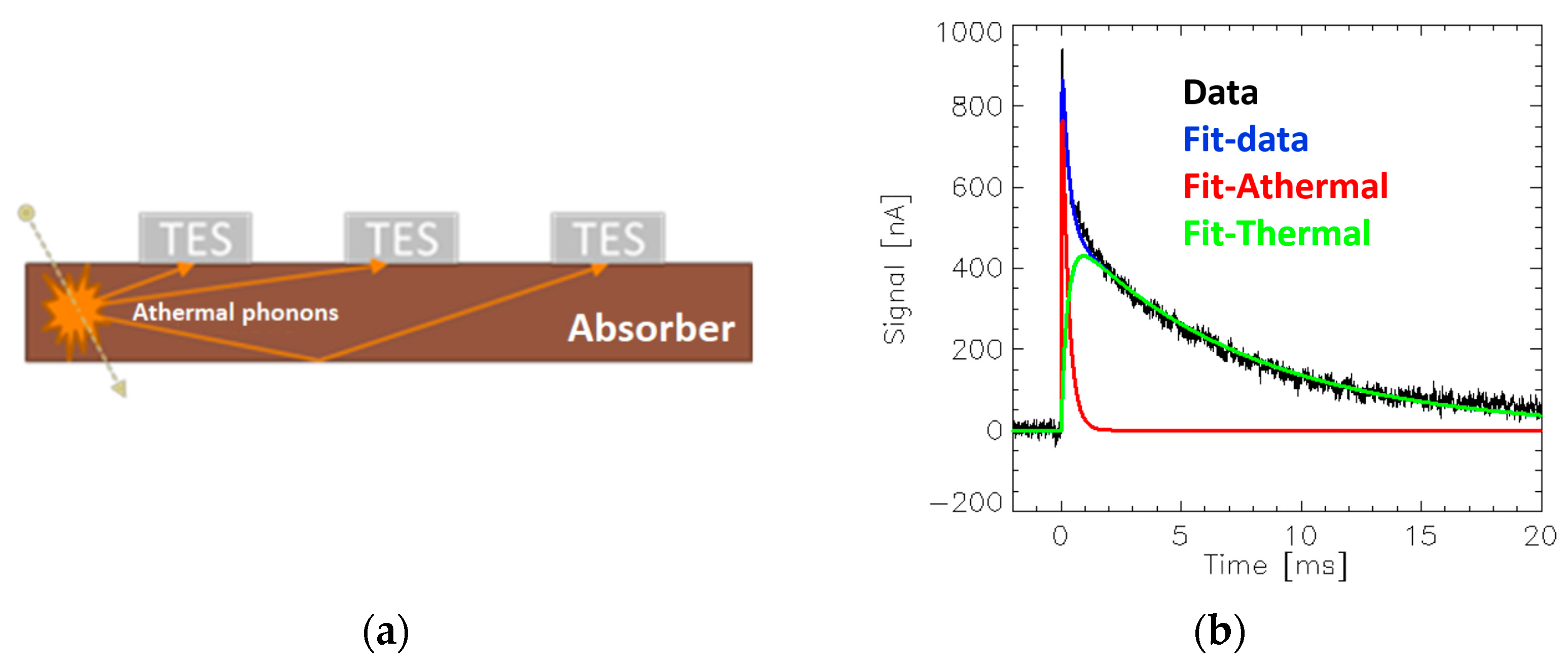
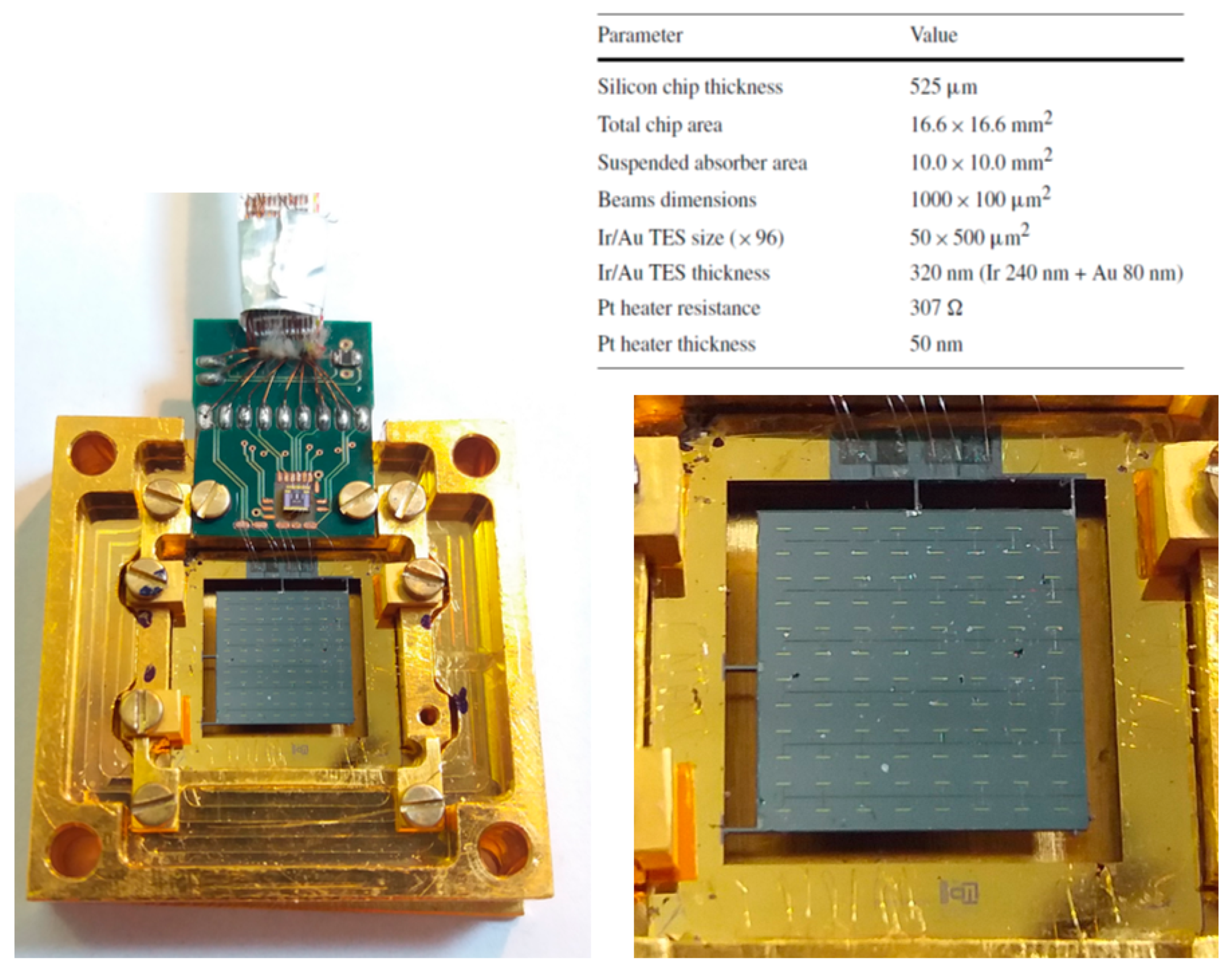



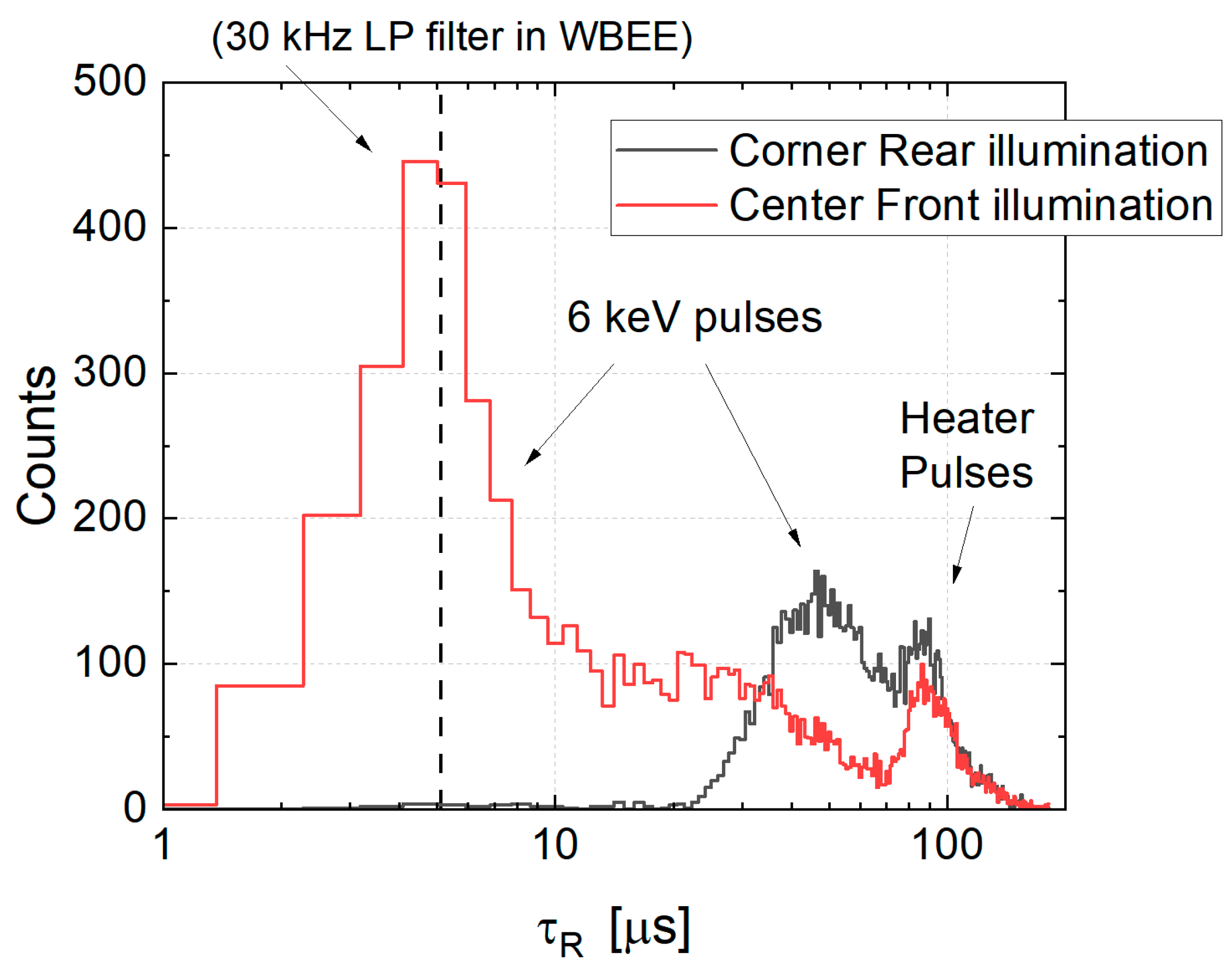
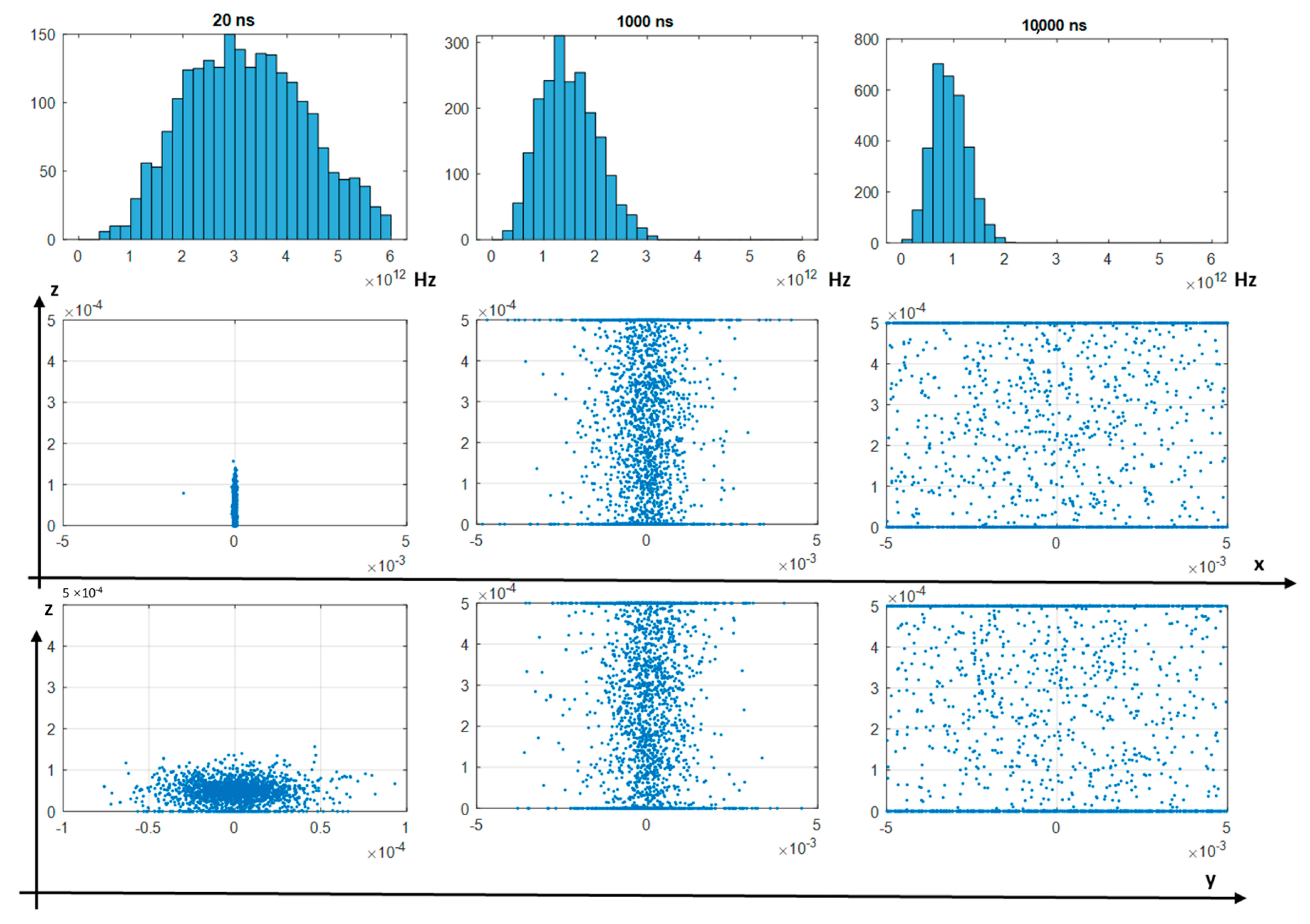



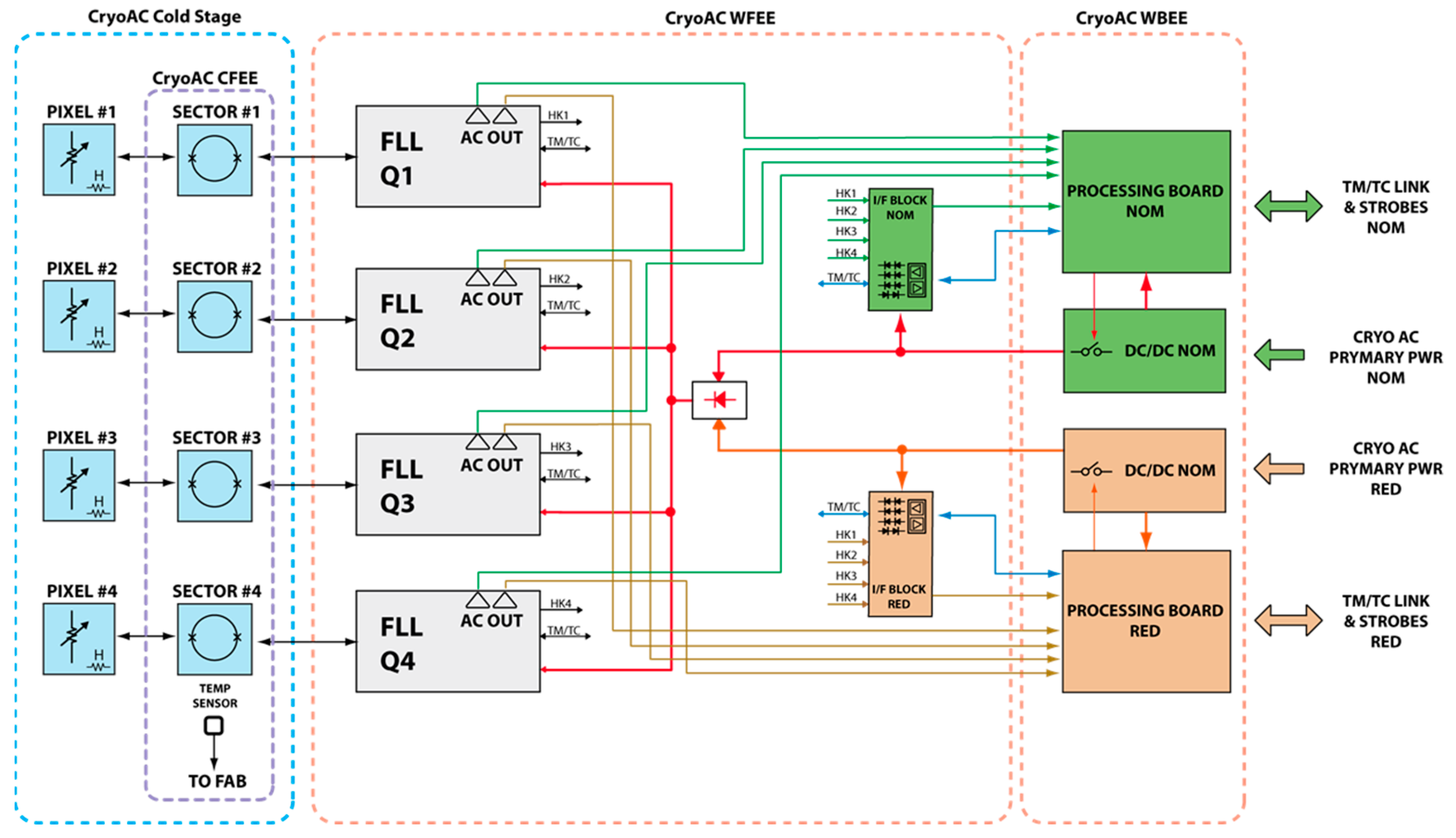

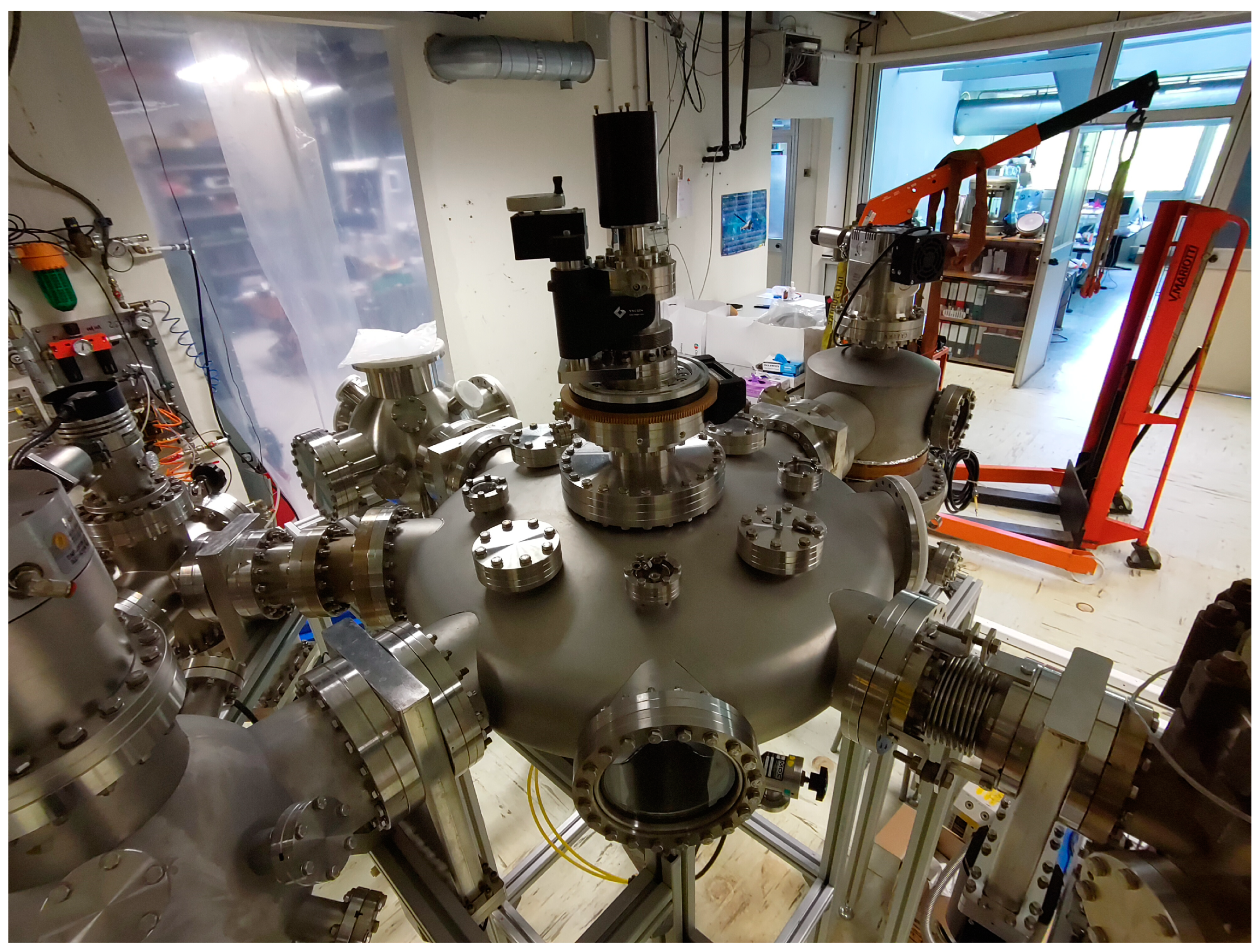

| Requirement and System Constraint | Value |
|---|---|
| Geometrical rejection efficiency | 98.5% |
| Detection efficiency | 99.98% |
| Trigger efficiency | 99.999% |
| Allocated power dissipation (50 mK) | <40 nW (CBE 1) |
| Time tagging accuracy | <10 µs (at 1 sigma) |
| Intrinsic deadtime | 1% |
| Thermal bath | 50 mK |
| Parameter | Value |
|---|---|
| Number of pixels | 4 |
| Pixel size | 1.23 cm2 (TBC due to newAthena) |
| Absorber thickness | 500 μm |
| Distance from X-IFU | <1 mm |
| Detector dynamic energy range | 6 keV–950 keV (TBC) |
| Rise time constant | <15 μs (TBC) |
| Effective fall time constant | 250 μs (TBC) |
| Thermal time constant | 2.5 ms (TBC) |
| ΔEFWHM@6 keV | <2500 eV |
| TES material | Ir/Au |
| Absorber material | Silicon |
| Transition temperature | 100 mK (TBC) |
| Parameter | DM#127 (Pheater = 0 nW) | DM [24,25] (Pheater = 0 nW) | CryoAC Requirement | Note |
|---|---|---|---|---|
| Low energy threshold | 1.4 keV | ~3 keV | <6 keV | |
| Bias current | 1 mA | 8 mA | <~3 mA requested by FPA | |
| Power dissipation @50 mK | 9 nW | 30 nW | <10 nW/pixel | Possible reduction by using heater and/or different shunt resistor |
| Rise time | 25 µs 2 | 15 µs | <15 µs | Compliant with time-tagging accuracy requirement if τR < 30 µs:
|
| ETF decay time | 1.3 ms | 700 µs | <250 µs | Achievable with higher α and higher silicon legs aspect ratio |
| Thermal decay time | 2.4 ms | ~3 ms | <2.5 ms | |
| ΔEFWHM@6 keV | 170 eV | 1300 eV | <2500 eV |
Disclaimer/Publisher’s Note: The statements, opinions and data contained in all publications are solely those of the individual author(s) and contributor(s) and not of MDPI and/or the editor(s). MDPI and/or the editor(s) disclaim responsibility for any injury to people or property resulting from any ideas, methods, instructions or products referred to in the content. |
© 2023 by the authors. Licensee MDPI, Basel, Switzerland. This article is an open access article distributed under the terms and conditions of the Creative Commons Attribution (CC BY) license (https://creativecommons.org/licenses/by/4.0/).
Share and Cite
Macculi, C.; Argan, A.; D’Andrea, M.; Lotti, S.; Minervini, G.; Piro, L.; Ferrari Barusso, L.; Boragno, C.; Celasco, E.; Gallucci, G.; et al. The Cryogenic Anticoincidence Detector for the NewAthena X-IFU Instrument: A Program Overview. Condens. Matter 2023, 8, 108. https://doi.org/10.3390/condmat8040108
Macculi C, Argan A, D’Andrea M, Lotti S, Minervini G, Piro L, Ferrari Barusso L, Boragno C, Celasco E, Gallucci G, et al. The Cryogenic Anticoincidence Detector for the NewAthena X-IFU Instrument: A Program Overview. Condensed Matter. 2023; 8(4):108. https://doi.org/10.3390/condmat8040108
Chicago/Turabian StyleMacculi, Claudio, Andrea Argan, Matteo D’Andrea, Simone Lotti, Gabriele Minervini, Luigi Piro, Lorenzo Ferrari Barusso, Corrado Boragno, Edvige Celasco, Giovanni Gallucci, and et al. 2023. "The Cryogenic Anticoincidence Detector for the NewAthena X-IFU Instrument: A Program Overview" Condensed Matter 8, no. 4: 108. https://doi.org/10.3390/condmat8040108
APA StyleMacculi, C., Argan, A., D’Andrea, M., Lotti, S., Minervini, G., Piro, L., Ferrari Barusso, L., Boragno, C., Celasco, E., Gallucci, G., Gatti, F., Grosso, D., Rigano, M., Chiarello, F., Torrioli, G., Fiorini, M., Uslenghi, M., Brienza, D., Cavazzuti, E., ... Bastia, P. (2023). The Cryogenic Anticoincidence Detector for the NewAthena X-IFU Instrument: A Program Overview. Condensed Matter, 8(4), 108. https://doi.org/10.3390/condmat8040108






